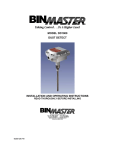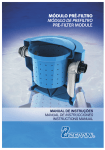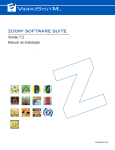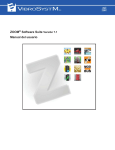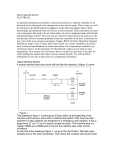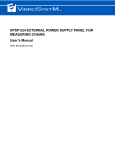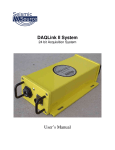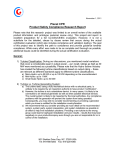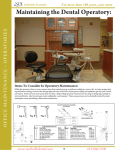Download 9483-26M9A-711
Transcript
ZOOM CONFIGURATION FOR ZPU-5000 STANDALONE WITH MODBUS User’s Manual Copyright © VibroSystM Inc., 2013 2 ZOOM Configuration for ZPU-5000 Standalone with Modbus - User’s Manual P/N: 9483-26M9A-711 TABLE OF CONTENTS 1. ZOOM CONFIGURATION FOR ZPU-5000 STANDALONE 1.1 1.2 1.3 1.4 Overview .......................................................................................................................................... Create a Configuration ..................................................................................................................... Create a Station ............................................................................................................................... Add a Machine ................................................................................................................................. 1.4.1 Machine Properties............................................................................................................... General Tab ..................................................................................................................... ZPU5000 Tab ................................................................................................................... Rotation Tab ..................................................................................................................... Stator Tab......................................................................................................................... 1.5 ZPU-5000 Configuration .................................................................................................................. 1.5.1 ZOOM ZPU5000 Configuration Overview ............................................................................ 1.5.2 Add a ZPU-5000 Acquisition Unit ......................................................................................... 1.5.3 Add the Modules................................................................................................................... 1.5.4 Add the Sensors ................................................................................................................... 1.5.5 Settings for Smax Value Calculation .................................................................................... 1.6 Modbus Configuration ...................................................................................................................... 1.6.1 ZOOM Modbus Configuration Overview............................................................................... 1.6.2 Add a Modbus Acquisition Unit............................................................................................. Modbus Acquisition Unit Properties - General.................................................................. Modbus Acquisition Unit Properties - RTU or ASCII Protocol .......................................... Modbus Acquisition Unit Properties - TCP Protocol ......................................................... 1.6.3 Modbus Publication .............................................................................................................. Modbus Publication Configuration Window ...................................................................... Modbus Publication Panel ................................................................................................ 1.7 Save the Configuration File.............................................................................................................. 5 6 7 7 8 8 10 10 10 11 11 11 12 14 16 18 18 18 19 19 19 19 20 20 21 2. EXPORT A ZOOM CONFIGURATION FILE TO A USB KEY 2.1 Export Procedure ............................................................................................................................. 22 3. IMPORT A LOCAL CONFIGURATION FILE 3.1 Import Procedure ............................................................................................................................. 23 4. MODIFY A CONFIGURATION FILE 4.1 Modification Procedure .................................................................................................................... ZOOM Configuration for ZPU-5000 Standalone with Modbus - User’s Manual 24 3 4 ZOOM Configuration for ZPU-5000 Standalone with Modbus - User’s Manual 1. ZOOM CONFIGURATION FOR ZPU-5000 STANDALONE 1.1 Overview This manual is intended as a guide to the use of ZOOM Configuration for ZPU-5000 Standalone and ZOOM Configuration for ZPU-5000 Standalone with Modbus. ZOOM Configuration is a graphic user interface tool used to create and customize configuration profile stored in local configuration files. These files can be exported to a USB key, and from there, loaded into a ZPU-5000 by an import command. The title bar contains ZOOM Configuration icon and window name, followed by the name of the configuration file. Available commands are presented in menus and are sorted by category. Some categories are available only when a particular type of node is selected in the configuration tree: Station, Machine, Acquisition Unit, Processing Unit, Sensor. Shortcuts to the most commonly invoked commands are available as icons placed in the toolbar. Some icons are displayed and available only when a particular type of node is selected in the configuration tree. Panels in the ZOOM Configuration window remain empty until a configuration file is opened. Once a configuration has been selected, content appears : • Configuration panel: The Configuration panel shows the various elements that make up the configuration in an arborescent structure. The first tab, Overview, displays all the configured equipment, from the station to individual sensors. Only the first two equipment levels (Station and Machine) can be added and edited from the Overview tab. A ZPU-5000 tab and, optionally, a Modbus tab are also present. Each tab is associated to its own Catalog panel to allow adding equipment. Equipment can be added and edited only from the corresponding view. ZPU-5000 units, associated acquisition modules and sensors can only be added and edited from the ZPU5000 tab. Similarly, Modbus items can only be added and edited from the Modbus tab. ZOOM Configuration for ZPU-5000 Standalone with Modbus - User’s Manual 5 • • Catalog panel: The Catalog panel contains icons representing the items available for building the configuration, grouped in various categories (processing units, firmware, modules, sensors). The contents of the Catalog panel varies, depending on which tab and node is currently selected in the Configuration panel. Display panel: This panel shows a representation of the machine, but serves no purpose in standalone operation. 1.2 Create a Configuration A .config configuration file is a temporary storage file used for creating a configuration. Configuration files can be edited, saved with the same name with the File>Save command, and saved under a new name with the File>Export to command. To create a new configuration file, proceed as follows: 1. From the File menu, select New (.config). 2. Enter a name for your configuration, and select the location where it will be stored. It is common practice to use the plant name. 6 ZOOM Configuration for ZPU-5000 Standalone with Modbus - User’s Manual 1.3 Create a Station 1. Drag the station icon from the Catalog panel to the configuration panel. 2. Enter the station or plant name (max.: 32 characters) and enter a short description (optional, max.: 32 characters). 1.4 Add a Machine The second level node in the configuration tree is a machine. Several machines may be associated to a station node. To add a machine to the configuration tree, proceed as follows: 1.Drag the Machine icon from the Catalog panel, and drop it on the Station node. Or you may also select Station>Add machine from the menu bar, or click Add Machine in the toolbar. A Machine Configuration dialog window will be presented. 2. Edit the machine properties in the Machine Configuration dialog window (see Section 1.4.1 Machine Properties). ZOOM Configuration for ZPU-5000 Standalone with Modbus - User’s Manual 7 1.4.1 • Machine Properties Monitored: to enable/disable data acquisition. It can be left unchecked at any time to temporarily suspend acquisition from this particular machine. Depending on the selected type of machine, the number and contents of tabs in the Machine Configuration window varies. Seven types of machine can be defined by their properties through the Machine Configuration window: • • • • • • • Hydroelectric generator (with bulb, Francis, Kaplan, or Pelton turbine) Turboelectric generator Motor Gearless SAG mill Gear drive SAG mill Gearless ball mill Gear drive ball mill 1.4.1.1 General Tab • • Machine: machine category - Hydro, Motor, Mill, or Turbo Type: depending on selected machine category, - if the selected category is Motor, one option only is available: Motor - if the selected category is Hydro, four options are available: Bulb, Francis, Kaplan, or Pelton. - if the selected category is Mill, four options are available: Gearless SAG mill, Gear drive SAG mill, Gearless ball mill, or Gear drive ball mill. - if the selected category is Turbo, one option only is available: Turbo. • • • Name: main designation for identification of this particular machine (max. 32 characters). Description: short description for further identification of the machine (max. 32 characters). Machine Number: unique numeral designation for this particular machine (optional). Features Depending on selected machine category, a varying number of features must be specified. a) Motor • • • 8 Number of Poles: as per manufacturer specifications (optional). Nominal Air Gap: as per manufacturer specifications (optional). Nominal Speed: as per manufacturer specifications (optional). ZOOM Configuration for ZPU-5000 Standalone with Modbus - User’s Manual b) Hydro • • • • • • • Number of Poles: as per manufacturer specifications. Number of Blades: as per manufacturer specifications. Blade offset angle: not required in a configuration for operation in standalone mode. Network Frequency: 25, 50, or 60 Hz cycle. Nominal Air Gap: as per manufacturer specifications (optional). Nominal Power: as per manufacturer specifications (optional). Nominal Speed: value calculated by ZOOM Configuration, from values provided for Network Frequency and Number of Poles. c) Gearless mill (SAG or ball type) • • • Number of Poles: as per manufacturer specifications. Nominal Speed: as per manufacturer specifications. Nominal Air Gap: as per manufacturer specifications (optional). d) Gear drive mill (SAG or ball type) • • Number of Teeth: as per manufacturer specifications. Nominal Speed: as per manufacturer specifications. e) Turbo • • • • Number of Poles: as per manufacturer specifications. Nominal Power: as per manufacturer specifications (optional). Network frequency: 25, 50, or 60 Hz cycle. Nominal Speed: value calculated by ZOOM Configuration, from values provided for Network Frequency and Number of Poles. ZOOM Configuration for ZPU-5000 Standalone with Modbus - User’s Manual 9 1.4.1.2 ZPU5000 Tab Time used to calculate trending (if no synchro): By default, most signal processes (except RMS) calculate trend values over one machine rotation. For example, Peak-to-Peak is the result of the maximum value on one turn, minus the minimum value on the same turn. With some sensors, the number of rotations used to calculate trend values can be adjusted to more than one machine rotation. Whether calculations are based on one or more than one machine rotations, the system relies on the synchronization signal to distinguish one rotation from the next. • If the synchronization signal is not available, a length of time is used to set the frequency at which trend values are to be calculated. A value is proposed by the system, based on the time for a rotation at nominal speed. This value can be adjusted to modify the frequency at which trend values are to be calculated. 1.4.1.3 Rotation Tab Rotation Direction: If the machine can rotate only in a single direction, rotor movement is either Clockwise or Counterclockwise. If the machine can rotate in both directions, Automatic Direction Detection must be selected as movement direction is determined by the state of an external contact. When Automatic Direction Detection option is selected, the next item, ZPU5000 Detection Control Input, becomes active. • ZPU5000 - Detection Control Input: If Automatic Direction Detection is selected, select the rotation direction to which corresponds a closed contact signal sent to the control module of the ZPU-5000 unit. Angle Numbering: One of two options indicates the angle numbering scheme around the axis of rotation, describing the placement of all sensors in the machine. The angle numbering starts at the reference position (0° upstream). Pole Numbering: One of two options indicates the pole numbering scheme, for pole identification if there is an alarm on an air gap sensor. • • • 1.4.1.4 Stator Tab The Stator tab is present for Motor, Hydro, Turbo, and Gearless mill (SAG or ball type) machines. Depending on the selected machine category, a varying number of features may be specified. All properties are optional. 10 ZOOM Configuration for ZPU-5000 Standalone with Modbus - User’s Manual 1.5 ZPU-5000 Configuration 1.5.1 ZOOM ZPU5000 Configuration Overview Select the ZPU5000 tab to configure the ZPU-5000 unit and all sensors connected to the ZPU-5000 unit. When the ZPU5000 tab is selected, the tree in the Configuration panel obeys to the following hierarchy: Station - Machine - ZPU5000 Processing Unit - ZPU5000 Acquisition Unit - Control and Acquisition Modules - Sensors. Adding a ZPU-5000 unit to a machine in the arborescence creates a ZPU5000 Processing Unit node and its ZPU5000 Acquisition Unit child node, to which is attached a Control module. Up to eight acquisition modules may be added to each ZPU5000 Acquisition Unit node. Each acquisition module contains two acquisition channels. Sensors are attached to these acquisition channels. 1.5.2 Add a ZPU-5000 Acquisition Unit To create a ZPU-5000 standalone processing unit: 1. To create a ZPU-5000 standalone processing unit, first select the ZPU5000 tab in the Configuration panel. 2. Drag a ZPU-5000 standalone item from the Catalog panel to the Machine node in the Configuration panel. ZOOM Configuration for ZPU-5000 Standalone with Modbus - User’s Manual 11 Or you may also select the Machine menu and select Add processing unit > ZPU5000 standalone in the menu bar. The Acquisition unit configuration window will then appear. 3. Enter the following information: Name: a designation for this particular processing unit (max: 32 characters). • Monitored: enables/disables acquisition. • Description: comments that provide more details on the acquisition unit (max.: 64 characters). • Address: a two-digit address assigned to the acquisition unit, generally a factory setting. Hysteresis: values used for air gap detection. A percentage representing the upper detection limit (saturation). Both values act as thresholds for pole detection. The minimum hysteresis level is the air gap value when pole detection starts. The maximum hysteresis level corresponds to the air gap value marking the end of pole detection. • • 1.5.3 Add the Modules Each acquisition module physically installed in the ZPU-5000 unit must be described in the correct location. 1. To add a module, drag the corresponding icon from the Catalog panel to the ZPU5000 acquisition unit node. 12 ZOOM Configuration for ZPU-5000 Standalone with Modbus - User’s Manual You may also select Acquisition channel > Add module in the menu bar to select a module to be added. 2. In the Module Configuration window, set the location. The Module drop down box shows the empty locations in the acquisition unit and allows choosing a physical location. 3. If needed, change the module version. Modules offered in the Catalog panel are, by default, of the latest version available. The configuration may include an earlier version of some modules. If this is the case, an earlier version can be selected from a list. Version 1 modules have a part number ending with 100 while Version 2 modules have a part number ending with 101 or higher. ZOOM Configuration for ZPU-5000 Standalone with Modbus - User’s Manual 13 1.5.4 Add the Sensors Once a module has been configured in the ZPU-5000, two acquisition channels are created for this module to which sensors can then be associated. 1. To add a sensor, drag the corresponding icon from the Catalog panel to an available acquisition channel in the Configuration Panel. VibroSystM sensors are identified by their name, and are associated to preset values. Any third-party sensor can be added by dragging the User item. Or you may also select (user-defined sensors only) the module in the Configuration Panel, and select Add sensor from the menu bar. The Sensor appear. Configuration window will 2. Monitored: to enable/disable data acquisition. The General tab identifies several basic input properties and settings. Enter the following information: • • • • 14 Name: a unique designation used to identify a sensor displayed in a list. Parameter: enter the physical phenomenon to be monitored. Location: the sensor position on the generator. Angular position: the sensor position according to the angle numbering defined for the generator. ZOOM Configuration for ZPU-5000 Standalone with Modbus - User’s Manual • • 3. The Range tab displays sensor properties such as the unit of measurement and measuring range. Access this tab to configure the sensor associated with the parameter selected in the General tab. • Unit: displays the units of measurement available for the parameter selected in the General tab. • Raw output range: when configuring a VibroSystM sensor, the analog module raw output range is automatically preset with the correct values. However, when configuring a capacitive sensor or a sensor supplied by a third party, the range must be entered. This range is the input as well as the output. For capacitive sensors, refer to your hardware documentation to enter the proper range. Processing: a signal processing for trending analysis (ex. Peak-to-Peak on a displacement sensor). Display and module trending output: range of the ZPU-5000 bar graph display, and of the analog module trending output. 4. Select the Alarm tab if needed to adjust the alarm thresholds. Alarm thresholds can be monitored to trigger a relay when an alarm occurs. When an alarm is associated to an input, the input name appears in bold in the Configuration panel. Threshold values can be monitored at both ends of the measuring range. If the parameter value needs to remain between the two threshold limits for safe operation, then both thresholds must be selected for monitoring. Maximum monitored: select this level if the parameter value must remain below this threshold. Minimum monitored: select this level if the parameter value must remain above this threshold. • • For each threshold limit, two levels of alarm are provided: Alert: a value equal to the limit of safe operation, at which a first alarm is triggered • Danger: a value equal to the limit considered critical, and an alarm requiring immediate action is triggered Levels can be adjusted by either entering a new value, or using the scrollbar control on the right. • The Measurement box allows selecting the type of measurement to be taken when an alarm event occurs. For alarm notifications that do not require a measurement, select the empty item in the Measurement box. ZOOM Configuration for ZPU-5000 Standalone with Modbus - User’s Manual 15 • • • 5. Select the Alarm Settings tab if needed to adjust various alarm parameters. • Auto reset: Select this option to allow any alarm condition triggered from this sensor to disappear without intervention once the signal that has triggered the condition returns to normal. When the Auto reset option is not selected, any alarm triggered from this sensor will remain active until it has been acknowledged through the keypad located on the front panel of the ZPU-5000 unit. (For more information, refer to the User’s Manual supplied with the ZPU-5000 unit). Delay mode: Select the terms of the delay to be added, in either time or number of rotations, before triggering and releasing the alarm relay to prevent false triggering on transient noise or other singular outof-range readings. Delay before alarm: Enter a value in either time or number of rotations, depending on selected delay mode, during which the alarm condition must be present before triggering the alarm. Delay after alarm: Enter a value in time or number of rotations, depending on selected delay mode, as the minimal delay after the alarm condition has cleared before stopping the alarm. 1.5.5 Settings for Smax Value Calculation When configuring two relative vibration sensors installed at a 90° angle from one another, the module can be configured to calculate the Smax value. Configure both sensors first, then select the module and right-click to select Properties from the contextual menu. 1. Select Smax in the Processing box. 16 ZOOM Configuration for ZPU-5000 Standalone with Modbus - User’s Manual 2. Next, enter a name in the Virtual input name dialog box. This name will be used to identify alarms if thresholds are configured and an alarm is triggered. 3. After a Processing has been chosen, a new tab called Vibration (channel X + channel Y) appears. This tab allows configuration of alarms on the Smax process. 4. The parameters under the Alarm settings tab of the Module Configuration window are similar to those under the Alarm settings tab of the Sensor Configuration window. (see Step 5 in Section 1.5.4 Add the Sensors) ZOOM Configuration for ZPU-5000 Standalone with Modbus - User’s Manual 17 1.6 Modbus Configuration 1.6.1 ZOOM Modbus Configuration Overview Select the Modbus tab to configure the communication via the Modbus protocol. When the Modbus is selected, the tree in the Configuration panel obeys to the following hierarchy: A Modbus acquisition unit can provide data to a plant control system or read data from a plant control system. When operating in a network environment which includes a ZOOM Controller, a Modbus acquisition unit can be either a Modbus Master or Modbus Slave. However, in a ZOOM configuration for operation of a ZPU-5000 in standalone mode, only the Modbus Slave type applies. Configuration of the Modbus gateway involves: • • adding a Modbus Slave configuring ZOOM data which must be provided to the plant control system (referred to as Publication in ZOOM) 1.6.2 Add a Modbus Acquisition Unit To make ZOOM data available to a plant control system, a Modbus Slave must first be created. Proceed as follows to add a Modbus Slave to the configuration: 1. In the Configuration panel, select the Modbus tab. 2. Drag the Modbus Slave icon from the Catalog panel to the ZPU5000 processing unit node in the Configuration Panel. Make sure you place the Modbus Slave on the ZPU5000 processing unit node and not on the machine node. You may also select the ZPU5000 processing unit node in the Configuration panel, and either click Add Acquisition channel on the toolbar, or select Processing Unit>Add acquisition channel on the menu bar. 3. Edit the information in the Acquisition unit configuration window. 18 ZOOM Configuration for ZPU-5000 Standalone with Modbus - User’s Manual 1.6.2.1 Modbus Acquisition Unit Properties - General • • • • • Name: enter a designation for this particular acquisition unit (max.: 32 characters). Monitored: select to enable data exchange for this Modbus acquisition unit. Description: add a comment to provide more detailed information about this acquisition unit (optional, max.: 64 characters). Type: select Modbus Slave to indicate that the ZOOM system responds to Modbus commands. Protocol: select Modbus RTU or Modbus ASCII for RS-422 or RS-455 communication. Select Modbus TCP for TCP/IP communication. Depending on the selected protocol, additional protocol-dependent properties will need to be set. 1.6.2.2 Modbus Acquisition Unit Properties - RTU or ASCII Protocol • • • • • • Address: communication port used for Modbus communication (always Port A). Parity: select the parity value matching the plant control system parity. Modbus id: enter a unique Modbus identification number. Mode: the communication mode (RS-485 or RS-422) used on the serial port must be specified. Bauds Rate: select the speed of the transmission link. Stop Bits: select the stop bits value matching the plant control system specifications. 1.6.2.3 Modbus Acquisition Unit Properties - TCP Protocol • • Address: enter the IP address of the ZPU-5000 unit. To view the IP address of the ZPU-5000 unit, press MENU on the front panel keypad, select Information, and select System. TCP Port: enter the TCP port used for Modbus communication (502 by default, may be changed if needed). 1.6.3 Modbus Publication To provide ZOOM data to a plant control system: 1. Select the Modbus Slave in the configuration panel. Select Configuration>Publication>Modbus from the menu bar. 2. Edit the information in the Publication Configuration window to define the configuration of all the ZOOM data to be provided to the plant control system. ZOOM Configuration for ZPU-5000 Standalone with Modbus - User’s Manual 19 1.6.3.1 Modbus Publication Configuration Window The Publication Configuration window allows the configuration of all the data to be provided to the plant control system. The tree in the left panel displays the equipment in the ZOOM configuration. The right panel displays the list of available items that may be provided to the plant control system. The list of available items in the right panel depends on the equipment selected in the left panel. To provide a single item, click on the selection box at the left of the item. Click the Check button in the toolbar to select all items, click the Uncheck button in the toolbar to unselect all items. Click the Print button in the toolbar to print a list of all items selected for publication. 1.6.3.2 Modbus Publication Panel The Modbus publication panel displays available data that may be provided to the plant control system. The information is divided into five columns: • • • • • (untitled): select the checkbox in the first column to enable publication of this item. Equipment: display which equipment is taking the measurement. Usually, it is a sensor. To clearly identify the equipment, the sensor is prefixed with the machine name and the acquisition unit name. Item: data item provided. Some sensors may have more than one available data item. For example, air gap sensors may provide the minimum, maximum, processed signal, and average value over a turn. Each of these values will have a distinct entry in the table. Data type: data provided is always of float value type. Register: enter the register address where to write the value. Be aware that 32-bit float values require two consecutive registers. To help you, you may use the Automatically generate register functionality. This functionality can be accessed in the Publication Configuration window by a right-click on the grid view. This will assign all registers to the selected items and ensure there is no conflict. 20 ZOOM Configuration for ZPU-5000 Standalone with Modbus - User’s Manual 1.7 Save the Configuration File To save a configuration, select File>Save from the menu bar, or click on the toolbar. If the configuration contains no error or warning, a successful completion message will be displayed. Click OK to acknowledge the message and continue. If the configuration contains warnings, a message will be displayed, and you will be asked to select whether you wish to continue saving the configuration or not. It is recommended to select No, and use the Configuration>Analysis tool to review the list of warnings. For operation of a ZPU-5000 in standalone mode, the configuration does not require definition of a user or automatic measurements. If the analysis tool reports only the following message and warning, then no further action is required: Other messages and warnings may be present to signal other missing or conflicting information in the configuration. You may select Yes if you wish to save the configuration, but you have to remember that it is still incomplete and will need to be finalized. If the configuration contains errors, you will not be allowed to save the configuration. Any error must be corrected immediately. ZOOM Configuration for ZPU-5000 Standalone with Modbus - User’s Manual 21 2. EXPORT A ZOOM CONFIGURATION FILE TO A USB KEY 2.1 Export Procedure A standalone configuration file is a unique file (.xml file extension) containing description parameters used by ZPU-5000 acquisition units. A standalone configuration file can be opened, edited, saved, and later loaded into the memory of a ZPU-5000 standalone unit through its USB port. To create a standalone configuration file, proceed as follows: 1. Place a USB key in a USB port on the computer. 2. Right-click on the ZP5000 Processing Unit node to access the contextual menu. 3. Select Export All, and USB drive - E:\ as the destination. 4. Once the export process is complete, a message is displayed to confirm that the configuration has been exported. Click OK. In this example, E:\ is the drive letter assigned to the first available USB port. The drive letter may differ on your system. 5. Verify that the USB key now contains a file named as follows: E:\Configurations\ZPU5000S\Import\ZPU5000SLocalConfig.XML 22 ZOOM Configuration for ZPU-5000 Standalone with Modbus - User’s Manual 3. IMPORT A LOCAL CONFIGURATION FILE A ZOOM configuration previously exported to a USB key can be loaded into a standalone ZPU-5000 unit by using the buttons and USB port located on the front panel of the ZPU-5000 unit. 3.1 Import Procedure 1. Press MENU on the front panel of the ZPU-5000 unit. 2. Select Configuration and press ENTER. 3. Select Import all Configurations... and press ENTER. 4. Insert the USB key in the front panel USB port and press ENTER. 5. Messages will appear - wait for the message Reboot is needed (menu Maintenance) to appear, and then remove the USB key. 6. Press Cancel twice to return to the main menu. 7. Select Maintenance and press ENTER. 8. Select Restart Unit... and press ENTER. 9. When the ZPU-5000 unit has finished rebooting, verify in the upper left corner of the screen that the mode is ’LOCAL’, and that the configuration is present. ZOOM Configuration for ZPU-5000 Standalone with Modbus - User’s Manual 23 4. MODIFY A CONFIGURATION FILE It is strongly recommended to retain a copy of the .config file, in case modifications are eventually needed. 4.1 Modification Procedure 1. From the ZOOM Configuration menu bar, select File>Open. 2. Select File, and browse to select and open the .config file. 3. In the Configuration panel, select the tab corresponding to the item to be modified. 4. To edit an item, access the item properties window by a double-click on the item name in the Configuration panel, or right-click on the item’s name and select Properties from the contextual menu. 5. When all modifications are completed, export the configuration file again to an USB key (refer to Section 2.1 Export Procedure), and import the local configuration file in the ZPU-5000 unit (refer to Section 3.1 Import Procedure). 24 ZOOM Configuration for ZPU-5000 Standalone with Modbus - User’s Manual
























